8-2 Early STEM Learning
A – STEM
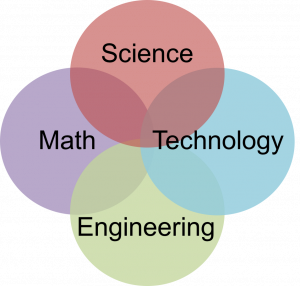
STEM is an umbrella term, referring to a group of subjects: science, technology, engineering, and math. The term started with the National Science Foundation. A new version of this acronym, STEAM, also includes an A for the arts, but we will be focusing here on STEM.
The subjects in STEM have a common approach and focus. They all require gathering and using evidence to create knowledge or solve problems. This approach emphasizes exploring, asking questions, observing, and then acting on those observations. By asking guiding questions and providing space for exploration and discovery, educators can help foster STEM learning for all children.
Head Start Early Learning Outcomes Framework connections include:
- STEM topics touch multiple domains in the framework.
- The Approaches to Learning domain includes executive function skills that are crucial to STEM exploration, such as initiative and curiosity, creativity, and cognitive self-regulation.
- By using both language and non-verbal communication to express interest and talk about what they observe, children are using skills found in the Language and Communication domain.
- The Cognition domain is especially relevant to STEM skill-building. All of its subdomains have core STEM skills.
STEM Experts
All children are STEM experts. Observing the world, making predictions, doing experiments, creating, solving problems—these are all skills that children use to understand and operate in their world from a very young age. To learn, grow, and thrive, children have to be able to observe patterns in the world, run simple experiments, learn from the results, and develop creative solutions.
Imagine an infant crawling. The child is noticing the feel of the flooring on their hands, focusing on balancing their core as they move their arms and legs, and planning their trajectory across the floor.
STEM Skill-Building
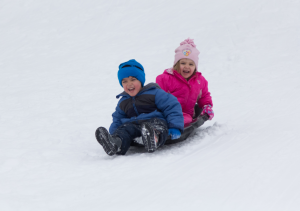
Now imagine young children in the snow. In this picture, children are learning that snow can be slick and they can slide down a hill of it on top of a smooth object.
Children in snow may notice their feet sinking in. They may notice that if they drag their feet they can make two lines. They may try to catch snowflakes and touch them or take handfuls of fallen snow. They may notice temperature when they find out the air feels cold.
Practicing Key Skills
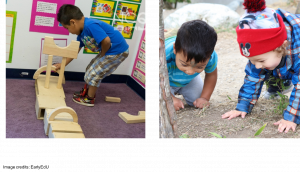
Here a child is building with wooden blocks. They are beginning to understand concepts like geometry, spatial relationships, balance, and symmetry.
Look at the children concentrating on the ground. They are observing something there, practicing a key skill for science exploration.
Children naturally use STEM as a tool to understand the world. They observe, note patterns, experiment, and form theories. Children don’t know they are doing it, and we may not always notice, but they are.
We’ll now cover how development within the Cognition subdomains relates to STEM learning.
Video: Let’s Talk about Stem: Everyday Fun with Science (4:19)
The video, Let’s Talk about Stem: Everyday Fun with Science, shows children from birth to age 5 doing STEM activities during different stages of development. It also introduces some terms used later in the session. It is 4 minutes, 19 seconds long.
While you watch the video, consider the following questions:
- How are young children developing STEM skills?
- What are ways you can foster children’s skills in these areas?
Watch Let’s Talk about Stem video from ZERO TO THREE on Vimeo

Video Debrief
How are children developing STEM skills? (click to toggle expand or collapse)
Possible Answer
You may consider that young children are developing STEM skills by:
- Making predictions
- Testing hypotheses
- Repeating tests
- Observing
- Exploring
- Testing cause and effect
- Explaining their thinking
And educators can foster these skills by:
- Letting the child lead the activity and follow their interests
- Asking open-ended questions
- Describing what the child is doing and discovering
- Making observations
- Pointing out patterns
B – STEM and Cognition
Science
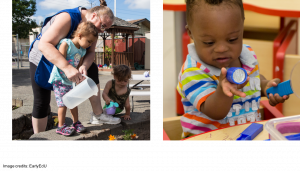
Children (and scientists) try to figure out just how the world works by engaging in a series of steps called the scientific method. The scientific method includes observing, forming questions, making predictions, designing and carrying out experiments, and discussing.
Children find patterns and build theories to explain what they see and collect data to test those theories. Toddlers make footprints by walking through a puddle. They may form a theory, based on their observation of their footprints, that the way they walk changes the size and shape of the prints. They then test their theory by hopping on one foot or walking on their toes to see if the prints change.
Science is about asking questions and trying to figure out how things work. You don’t need microscopes or test tubes to do science. Exploring, making observations, asking questions, developing predictions, and discussing the results are key science skills that will set the foundation for a lifetime of exploration and discovery.
Science in the Cognition Domain
Since science is all about inquiry, any of children’s developing skills that help them gather more information are going to be important for science learning.
At least two subdomains of the Cognition domain in the Head Start Early Learning Outcomes Framework are particularly relevant to science:
- Exploration and Discovery
- Memory
Exploration and Discovery is all about inquiry. It is about exploring the world, asking questions, forming answers, and then testing those answers to see if you need to make modifications. This is essentially the scientific method. And it comes naturally to children.
The other subdomain that is particularly relevant is Memory. As we covered earlier, the Memory subdomain includes children’s developing ability to remember whether they have seen or heard something before and to notice changes in familiar objects or scenes. These skills are critical to the observation part of science. To come up with theories about the world, you first have to be able to observe the world and remember what you have seen. To update your theories at a later point, you need to remember what you saw before and notice how things might be different now.
Understanding how children’s cognitive development connects to learning in different STEM areas helps educators to develop effective learning activities.
Technology
Children today grow up with technology all around them. Many children are familiar with digital technology, such as cell phones and tablets. Yet, these technologies don’t allow children to see the underlying cause and effect.
Some of the most important technology is simple, such as pulleys, wheels, levers, scissors, and ramps. These are the technologies of play.
These simpler technologies allow children to understand how tools help us accomplish tasks. Children can see causes and effects. One example is that adding wheels below a large object makes it easier to move.
Technology in the Cognition Domain
Multiple areas of the Cognition domain are relevant to technology, including:
- The Exploration and Discovery subdomain includes object exploration, which leads children to discover object properties and is necessary for discovering how to both use tools effectively and to choose the most appropriate tool for a task.
- The Reasoning and Problem-Solving subdomain explicitly includes the development of tool-use as a problem-solving strategy. This is one of the goals of development during this period.
- Emergent Mathematical Thinking includes the development of spatial awareness, which also applies to understanding how a tool can work to help complete a task. If you don’t know that to get something out of reach, you need an object long enough to reach it, you are going to have a very hard time finding the right tool for the task.
Some of the materials that children use as they explore technology include scissors and zippers, light switches and flashlights, computers and tablets, phones and batteries, wheels and gears, robots, cameras, and even paper airplanes.
Engineering
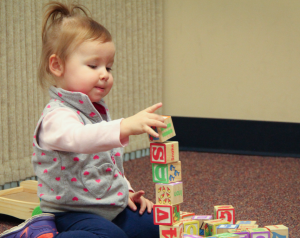
Engineering is about applying science, math, and technology to solve problems. It consists of designing and building.
When children design and build block structures or railroad tracks, they are acting as engineers. When they construct a fort of snow, pillows, or cardboard, they are solving structural problems like engineers. When they figure out how to pile sticks and rocks to block a stream of water or how objects fit together, they are engineering.
Learning about the characteristics of building materials, like mud and sand, also relates to engineering.
Engineering in the Cognition Domain
At least three areas of the Cognition domain are relevant to engineering:
- Memory
- Reasoning and Problem-Solving
- Emergent Mathematical Thinking
The Memory subdomain includes the development of memory for routines or multi-step processes. This is important for planning future actions, which is necessary for engineering. To build things effectively, it is best to plan what you are going to do before you build.
The Reasoning And Problem-Solving subdomain specifically includes the development of planning solutions to problems. Problems are always arising in engineering tasks and being able to examine a problem and plan a solution is very important to success on engineering tasks.
The Emergent Mathematical Thinking subdomain includes spatial awareness, which is not only important for tool-use and choice but also for figuring out how to engineer or build those tools in the first place. Spatial knowledge is important for many areas of cognitive development.
Math
Any time a child compares amounts (more, less) or sizes (big, little), notices a sequence, plays hopscotch, estimates a distance, or counts, that child is using math.
A child may say: “She has more than I do!” or “That’s too big to fit!” or “1…2…3…go!” That child is using math.
Infants and toddlers learn early math concepts like geometry and spatial relationships when they explore new objects with their hands and mouths. Adults can support math learning with the language they use. Words like over and under or in and out teach spatial concepts.
Math in the Cognition Domain
The primary area of the Cognition domain that is relevant to math learning is Emergent Mathematical Thinking.
Vroom Tip
Check out this Vroom tip to get more ideas about how to help build children’s early math skills.
Does this tip make sense in the context of an early learning environment? If not, how might you adapt the activity to better fit that environment?
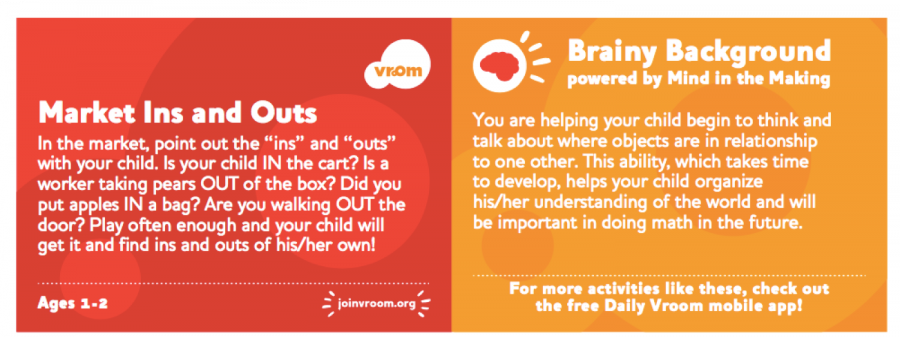
View text-only alternative of this Vroom card
Market Ins and Outs
In the market, point out the “ins” and “outs” with your child. Is your child IN the cart? Is a worker taking pears OUT of the box? Did you put apples IN a bag? Are you walking OUT the door? Play often enough and your child will get it and find ins and out of his/her own!
Ages 1-2
Brainy Background powered by Mind in the Making
You are helping your child begin to think and talk about where objects are in relationship to one another. This ability, which takes time to develop, helps your child organize his/her understanding of the world and will be important in doing math in the future.
 References
References
U.S Department of Health and Human Services, Administration for Children and Families, Office of Head Start, Early Head Start National Resource Center. (2014, May). News you can use: Early science learning for infants and toddlers. [PDF]
Vroom. (n.d). Vroom tips. [PDF]
Zero To Three. (n.d.). Everyday fun with science: Let’s talk about STEM video. [Video]
EarlyEdU Alliance (Publisher). (2018). 8-2 Early STEM learning. In Child Development: Brain Building Course Book. University of Washington. [UW Pressbooks]

